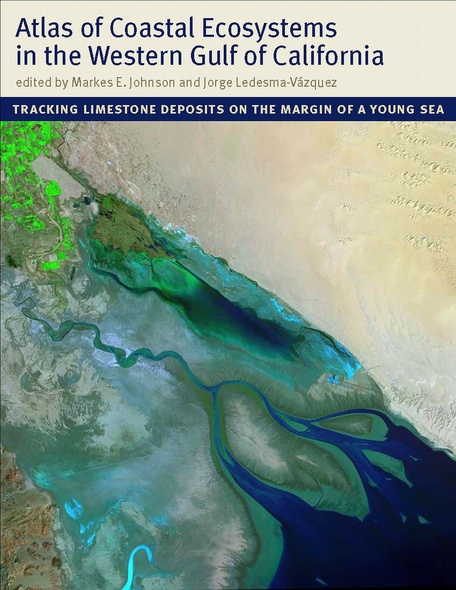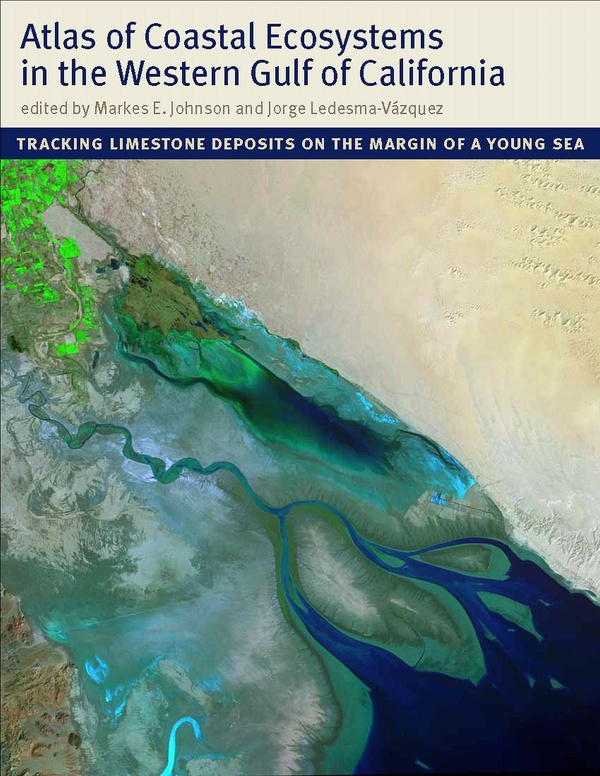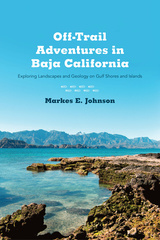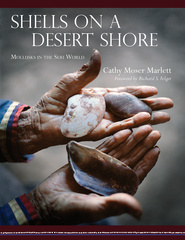Atlas of Coastal Ecosystems in the Western Gulf of California
Tracking Limestone Deposits on the Margin of a Young Sea
Edited by Markes E. Johnson and Jorge Ledesma-Vásquez
The University of Arizona Press
The Gulf of California is one of the most beautiful places in the world, but it is also important to earth and marine scientists who work far beyond the area. In text and an accompanying CD-ROM with stunning satellite images, this atlas captures the dynamics of natural cycles in the fertility of the Gulf of California that have been in near-continuous operation for more than five million years. The book is designed to answer key questions that link the health of coastal ecosystems with the region’s evolutionary history: What was the richness of “fossil” ecosystems in the Gulf of California? How has it changed over time? Which ecosystems are most amenable to conservation?
With an emphasis on the intricate workings of the Gulf, a team of scientists led by Markes E. Johnson and Jorge Ledesma-Vázquez explores how marine invertebrates such as corals and bivalves, as well as certain algae, contribute to the operation of a vast “organic engine” that acts as a significant carbon trap. The Atlas reveals that the role of these organisms in the ecology of the Gulf was greatly underestimated in the past. The organisms that live in these environments (or provide the sediments for beaches and dunes) are mass producers of calcium carbonate. Until now, no book has considered the centrality of calcium carbonate production as it functions today across multiple ecosystems and how it has evolved over time.
An important work of scholarship that also evokes the region’s natural splendor, the Atlas will be of interest to a wide range of scientists, including geologists, paleontologists, marine biologists, ecologists, and conservation biologists.
With an emphasis on the intricate workings of the Gulf, a team of scientists led by Markes E. Johnson and Jorge Ledesma-Vázquez explores how marine invertebrates such as corals and bivalves, as well as certain algae, contribute to the operation of a vast “organic engine” that acts as a significant carbon trap. The Atlas reveals that the role of these organisms in the ecology of the Gulf was greatly underestimated in the past. The organisms that live in these environments (or provide the sediments for beaches and dunes) are mass producers of calcium carbonate. Until now, no book has considered the centrality of calcium carbonate production as it functions today across multiple ecosystems and how it has evolved over time.
An important work of scholarship that also evokes the region’s natural splendor, the Atlas will be of interest to a wide range of scientists, including geologists, paleontologists, marine biologists, ecologists, and conservation biologists.
“For those of us who can’t go there in person, we can enjoy a vicarious visit by perusing the Atlas of Coastal Ecosystems in the Western Gulf of California by Markes Johnson and Jorge Ledesma-Vasquez. This geological vignette is but an apophoreta for what remains to be studied and described in the rest of the Gulf. Coastal researchers should be grateful for the editor’s masterful approach to the region and thorough explanations of the limestone deposits on the margins of this young sea.”—Charlie Finkl, Journal of Coastal Research
“The book provides a lot of material for theoretical considerations by geologists, palaeontologists, geographers, ecologists, and biologists as well as many nice examples for teaching. [It] also enables the readers with a good methodological framework, which can be employed in similar multi-disciplinary investigations in the other parts of the world.”—D.A. Ruban
Markes E. Johnson has been interested in marine geology since fossils in Paleozoic limestone first caught his eye as a boy. He is presently Charles L. MacMillan Professor of Geology at Williams College, whose students he has been introducing to Baja California's ancient shorelines for more than a decade. Jorge Ledesma-Vázquez is Associate Dean of the Facultad de Ciencias Marinas, Universidad Autónoma de Baja California natu ral histo ry / ecology (UABC), Ensenada in Mexico.
1 Gulf of California Geography, Geological Origins, Oceanography, and Sedimentation Patterns
Jorge Ledesma-Vázquez, Markes E. Johnson, Oscar Gonzalez-Yajimovich, and Eduardo Santamaría-del-Angel
2 Peninsular and Island Rocky Shores in the Gulf of California
David H. Backus, Markes E. Johnson, and Jorge Ledesma-Vázquez
3 Pliocene and Pleistocene Development of Peninsular and Island Rocky Shores in the Gulf of California
Markes E. Johnson and Jorge Ledesma-Vázquez
4 Corals and Coral-Reef Communities in the Gulf of California
Héctor Reyes-Bonilla and Ramón Andrés López-Pérez
5 Coral Diversification in the Gulf of California During the Late Miocene to Pleistocene
Ramón Andrés López-Pérez and Ann F. Budd
6 Living Rhodolith Bed Ecosystems in the Gulf of California
Diana L. Steller, Rafael Riosmena-Rodríguez, and Michael S. Foster
7 Contribution of Rhodoliths to the Generation of Pliocene-Pleistocene Limestone in the Gulf of California
Markes E. Johnson, David H. Backus, and Rafael Riosmena-Rodríguez
8 Ecological Changes on the Colorado River Delta: The Shelly Fauna Evidence
Guillermo E. Avila-Serrano, Miguel A. Téllez-Duarte, and Karl W. Flessa
9 Growth of Pliocene-Pleistocene Clam Banks (Mollusca, Bivalvia) and Related Tectonic Constraints in the Gulf of California
Markes E. Johnson, Jorge Ledesma-Vázquez, and Astrid Y. Montiel-Boehringer
10 Sand Dunes on Peninsular and Island Shores in the Gulf of California
David H. Backus and Markes E. Johnson
11 Beach Deflation and Accrual of Pliocene-Pleistocene Coastal Dunes of the Gulf of California Region
Markes E. Johnson and David H. Backus
12 Active Geothermal Springs and Pliocene-Pleistocene Examples 1
Matthew J. Forrest and Jorge Ledesma-Vázquez
ASTER Image Maps and CD
Bibliography
About the Editors
About the Contributors
Index







